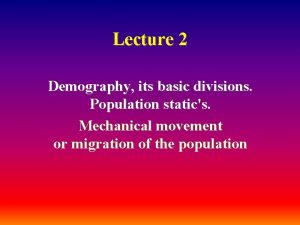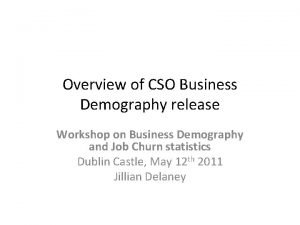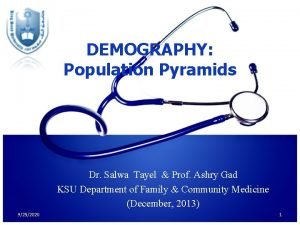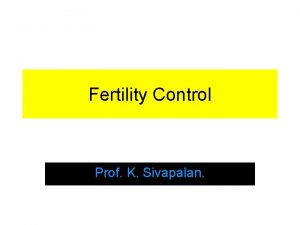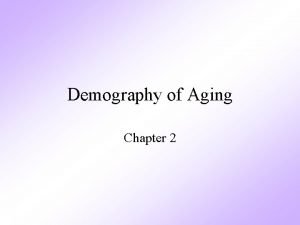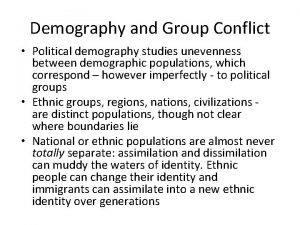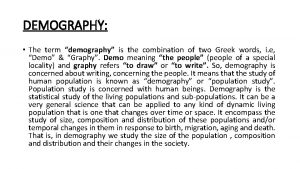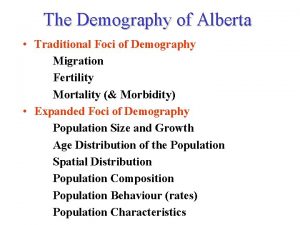Introduction to fertility In Demography the word fertility





























- Slides: 29

Introduction to fertility • In Demography, the word ‘fertility’ refers to the number live births women have • It is a major component of population change • Of late, fertility in India is declining at a steady pace • Data used to estimate various fertility and mortality indicators at the district level

Questions on fertility Question Para Q. 27: Children Surviving 6. 233 Number of children surviving at present (also include daughters and sons presently not staying) Q. 28: Children ever born 6. 237 Total number of children ever born alive (include both living and dead daughters and sons) Q. 29: Number of children born alive 6. 243 during last one year (1 st March, 2010 to 28 th Feb. , 2011)

Questions on fertility Remember • Questions 27 and 28 are to be asked to all currently married, widowed, separated and divorced women of any age for whom code ‘ 2’ or ‘ 3’ or ‘ 4’ or ‘ 5’ is entered under Question 5 of the Household Schedule. These women are called ‘ever married women’ in census.

Questions on fertility Remember • Question 29 will be asked to all currently married women for which only code ‘ 2’ is entered under Question 5 of the Household Schedule

Q. 27: Children surviving • It is required to find out the number of daughters and sons born to the ever married woman, who are still surviving at the time of enumeration and then the same may be put in the appropriate boxes under the Question 27. • This includes the total number of children born to her from all the marriages she had. A woman may have more than one marriage during her life time.

Q. 27: Children surviving Remember • The number of children surviving should include those living with the mother in the household and those living elsewhere in the country or abroad, no matter where they reside and regardless of their age and marital status.

Q. 27: Children surviving Remember contd… • It has been our experience that many persons especially older women may not count their children especially married daughters, who are not currently present in the household.

Q. 27: Children surviving: Method of probing • In order to avoid missing any surviving child, whether son or daughter, it will be appropriate to break up the Question 27 in four parts in terms of the following: (a) Total number of daughters living in the household; (b) Total number of daughters living elsewhere; (c ) Total number of sons living in the household; (d) Total number of sons living elsewhere.

Q. 27: Children surviving: Method of probing contd… Total nos. daughters living in the household Total nos. sons living in the household Total nos. daughters living elsewhere Total nos. sons living elsewhere + = Total nos. surviving daughters + = Total nos. surviving sons

Q. 27: Children surviving: Method of probing contd… • You should ascertain at this stage from each ever married woman in the household, who reported one or more surviving children living in the household, to identify them in the Household Schedule (Q. 1).

Q. 27: Children surviving: Method of probing contd… • That will ensure the correctness of their reporting to some extent. If number of daughters and sons as reported at (a) and (c ) respectively do not tally with what have been reported in Q. 1, then the reasons for the same may be ascertained and if there is inconsistency due to mis-reporting, necessary corrections may be made either in Q. 1 or Q. 27.

Q. 27: Children surviving: Method of probing contd… • If there are no daughters or sons reported to be surviving at the time of enumeration, write ‘ 0’ in the appropriate box/es. Do not put dashes (-).

Q. 28: Children ever born • Record the number of daughters and sons that was ever born alive to the ever born woman, you have enumerated under Question 27.

Q. 28: Children ever born Remember (Errors to be avoided) 1. Misunderstanding of the Question (a) The mortality error: It arises when the respondents report only the number of children who are still alive rather than those ever born (that is, exclude deaths). (b) Non-resident error: This is caused by over-looking the alive children, who are not residing with the mother.

Q. 28: Children ever born Remember (Errors to be avoided) 1. Misunderstanding of the Question (c) The marriage error: This occurs when the question is pertinent to all marriages and the women who have been married more than once do not include their children to previous marriages in their report.

Q. 28: Children ever born Remember (Errors to be avoided) 2. Respondents’ lapse of memory (a)The memory error: This is caused by tendency on the part of some mothers, especially, the elderly to forget to include some of their children who had died.

Q. 28: Children ever born Method of probing Total nos. surviving daughters + Total nos. daughters born alive but died before enumeration = Total nos. daughters ever born alive during the lifetime of the ever married woman Total nos. surviving sons + Total nos. sons born alive but died before enumeration = Total nos. sons ever born alive during the lifetime of the ever married woman

Q. 28: Children ever born Method of probing • Inconsistencies in the figures, if any, can be resolved during the interview.

Q. 28: Children ever born Method of probing (Remember) • The number of daughters and sons ever born alive to a mother will include the children born to her out of her earlier marriage (s) also, if any. • The children that her husband had from his earlier marriage (s) will not be included. • Adopted daughter (s) and son (s) will not be counted for the purpose of this question.

Q. 28: Children ever born Method of probing (Remember) • A child, who lived for a few moments after birth, that is, showed any sign of life, should be counted as live born. Still births or foetal deaths, that is, children born dead will also be excluded. • If the woman reports that she has had no daughter or son born alive, write ‘ 0’ in the appropriate box (es) under this question.

Q. 29: Children born alive during last one year • Find out the number of daughter (s) and son (s) born to a currently married woman in the last one year prior to the date of enumeration, that is, between 1 st March, 2010 and 28 th February, 2011. and record the number in the appropriate boxes under the question.

Method of probing • If mother reports one or more children born to her during the specified period, then it should be asked whether the child or children are present in the house. If the reply is ‘yes’, then check, whether the child/children have been reported in Q. 1 of the Household Schedule with age ‘ 000’. which you are canvassing and the same is accounted for in Questions 27 and 28. If no entry under Q. 1, then the reason for the same like death etc. may be ascertained.

Method of probing cont… • If she reports that no child was born during the specified period, then ask about the birth of any child/children born to her, who might have died before the date of enumeration. It has been the experience that such births are missed in large numbers.

Method of probing cont… • Tactful probing pertaining to children born and died within one year of birth, during the specified period is called for. The word ‘tactful’ is used since this is a delicate question. Specimen question pertaining to this is in the Instruction Manual (Para 6. 244 -pp 97 -98).

Method of probing cont… • If you are convinced after probing that the woman had not given live birth to any child during last one year, then record ‘ 0’ in both the boxes under this question. Do not put dashes (-).

Method of probing cont… • In a case where the woman has had twins or multiple births, write the number of male and/or female children in the appropriate boxes under this question. Consistency checks may be made with responses to Qs. 27 and 28 as well as Q. 1 and Q. 4 as discussed earlier.

Method of probing Example • If a son is born alive during last one year between 1 March 2010 and 9 February 2011, which was the first issue and he has died on 15 Feb, 2011, then the entries under Qs. 27, 28 and 29 (for sons) will be must be ‘ 0’, 1 and 1 respectively.

Method of probing Important • For the 3 questions on fertility (Q. 27 -29), it would be advisable to obtain the information directly from the concerned female members of the household. If the respondent is any male member of the household , then you may request him to invite the concerned woman to provide information on these questions.

 Static demography
Static demography Cso business demography
Cso business demography Elements of demography
Elements of demography Hotelling model ap human geography
Hotelling model ap human geography Demographic data definition
Demographic data definition Source of demographic data
Source of demographic data Components of demography
Components of demography Deforestation antonym
Deforestation antonym Hát kết hợp bộ gõ cơ thể
Hát kết hợp bộ gõ cơ thể Bổ thể
Bổ thể Tỉ lệ cơ thể trẻ em
Tỉ lệ cơ thể trẻ em Chó sói
Chó sói Thang điểm glasgow
Thang điểm glasgow Alleluia hat len nguoi oi
Alleluia hat len nguoi oi Môn thể thao bắt đầu bằng chữ đua
Môn thể thao bắt đầu bằng chữ đua Thế nào là hệ số cao nhất
Thế nào là hệ số cao nhất Các châu lục và đại dương trên thế giới
Các châu lục và đại dương trên thế giới Công thức tính độ biến thiên đông lượng
Công thức tính độ biến thiên đông lượng Trời xanh đây là của chúng ta thể thơ
Trời xanh đây là của chúng ta thể thơ Mật thư tọa độ 5x5
Mật thư tọa độ 5x5 Phép trừ bù
Phép trừ bù độ dài liên kết
độ dài liên kết Các châu lục và đại dương trên thế giới
Các châu lục và đại dương trên thế giới Thơ thất ngôn tứ tuyệt đường luật
Thơ thất ngôn tứ tuyệt đường luật Quá trình desamine hóa có thể tạo ra
Quá trình desamine hóa có thể tạo ra Một số thể thơ truyền thống
Một số thể thơ truyền thống Bàn tay mà dây bẩn
Bàn tay mà dây bẩn Vẽ hình chiếu vuông góc của vật thể sau
Vẽ hình chiếu vuông góc của vật thể sau Nguyên nhân của sự mỏi cơ sinh 8
Nguyên nhân của sự mỏi cơ sinh 8
